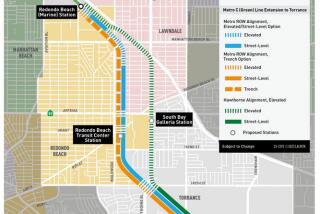Sinkhole Undermines Part of Freight Railway
- Share via
An underground tunneling mishap that created a sinkhole in southeast Los Angeles forced authorities to temporarily close one of three tracks on the Alameda Corridor rail line, officials said Thursday.
The depression caused no damage to the tracks that carry cargo from the ports of Los Angeles and Long Beach to rail yards near downtown, officials said.
Still, all cargo was diverted from the track nearest the depression as a precaution, said Phil Hampton, a spokesman for the Alameda Corridor Transportation Authority. It reopened Thursday night.
The 5-foot-wide depression was blamed on the work of a contractor for Los Angeles who was tunneling under the tracks for a storm drain project near 25th Street and Santa Fe Avenue, Hampton said. The transportation agency was not aware of the work until Tuesday night, when the sinkhole was reported.
“They excavated a little more ground than they should have,” said Cora Jackson-Fossett, a spokeswoman for the city Department of Public Works.
By coincidence, the track that was closed was already scheduled to be shut down Wednesday for regular maintenance. By Wednesday, Los Angeles city crews had filled the depression with slurry to stabilize the soil.
The 20-mile rail expressway was completed in April at a cost of $2.4 billion, earning the distinction of being the state’s largest public works project. Its centerpiece is a 10-mile section that runs in a 33-foot-deep trench through six cities.
The sinkhole occurred near a section where the tracks rise from the trench to the surface, just north of the city of Vernon.
Before the corridor was built, cargo trains lugged containers along surface tracks, blocking streets and creating traffic jams throughout south Los Angeles County. The project consolidates 90 miles of branch rail lines into one corridor, allowing cargo trains to travel up to 40 mph.
Corridor officials say the project is crucial to the future of the region because the volume of cargo from the ports is expected to nearly quadruple within the next 25 years.
More to Read
Sign up for Essential California
The most important California stories and recommendations in your inbox every morning.
You may occasionally receive promotional content from the Los Angeles Times.











